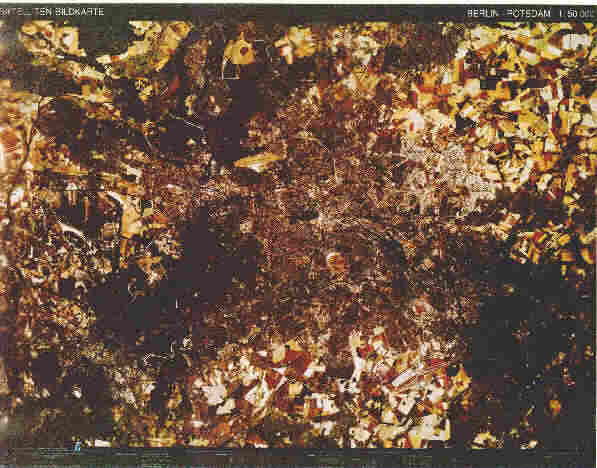
Documentation / Online Handbook
| The Federal State of the City of Berlin |

Berlin lies on the great plain of the North German flatlands. The city covers an area of
889 km². It extends over 38 km from north to south, and 45 km from east to west. The average height above sea-level is 34 m and the variation of altitude throughout the region is very slight. The highest elevations are the Teufelsberg and the Müggelberge (115 m high), both of which were built from wartime rubble.
The climate is continental, though it is also influenced by tradewinds from the Atlantic.
Forests and lakes cover an area of 24 % of city’s surface. The Spree River valley crosses the city from west to east, contributing to the 197 km of navigable channels and rivers.
Berlin’s urban structure consists of a settlement area with 47 % built land and 8 % used for traffic infrastructure. 43 % of the landscape in Berlin is considered open space and consists of 17 % forest, 12 % parks, 7 % agricultural areas, and 7 % lakes. 20 % of the open space is protected land.
With an estimated 3.5 million inhabitants, Berlin is the largest city in Germany. It is also one of the sixteen States, or Bundesländer, of the Federal Republic of Germany. The Governing Mayor of Berlin has a unique position, simultaneously serving as the city’s chief and its Prime Minister. The Senators act as both State Ministers and local heads of departments. The unified municipality of Berlin is a decentralized body divided into 23 boroughs or Bezirke.
Berlin is the largest industrial city between Paris and Moscow. Of the 1.5 million citizens in the workforce, approximately 50 % work in the service industry; 15 % in trade; 13 % in industry; and 13 % work in public administration.
Electrical engineering is the largest industrial sector in Berlin, employing approximately 31.4 % of the working population.
The other major economic sectors include mechanical engineering, motor vehicle engineering, the chemical industry, the food industry, research and development.
The unification of East and West Berlin has created great challenges in terms of urban and regional planning. Prior to 1990, a regional plan for Berlin was impossible, and until unification, the two sides of the city were developed independently. A land use plan now exists for the whole city, as well as a landscape program. The projects include the restoration and construction of public transit infrastructure, highway systems and industrial sites. Due to the severe housing shortage in Berlin, much of the planning is also focused on new and renovated housing developments. The states of Brandenburg and Berlin have developed a policy of "decentralized concentration," which will help avoid "strip" development, while protecting much of the region’s natural beauty. New urban centers will be developed along existing S-Bahn lines, encouraging the use of public transportation.
The envolved administration, Berlin Ministry of Urban Planning, Environmental Protection and Technology (SenSUT)
SenSUT , which is a regional ministry , has approximately 900 employees. As is it responsible for the compilation of both the urban and landscape master plan, basic enviromental informations are of big importance. Therefor the directorate IIIA3, a research group of planners, naturalist and software specialist, was engaged with the analysis and organisation of the enviromental fundamentals of Berlin. The Enviromental Atlas was realised starting from 1985, which then developed into the enviromental information system of Berlin.
Reference adress BERLIN
Mr Franz Ellermann
Ms Bettina Fellmer
Mr Thomas Schneider
Senatsverwaltung f. Stadtentwicklung,
Umweltschutz und Technologie
Abt. IIIA3
Brueckenstr. 6,
D-10179 BERLIN
tel.+49.30.9025-2135, fax.-2929
e-mail:
bettina.fellmer@sensut.verwalt-berlin.de
MINISTRY of URBAN PLANNING, ENVIRONMENTAL PROTECTION and TECHNOLOGY - BERLIN (April 1998)
| SENATOR |
Office Manager Assistant to the Senator Director of Publications/Press |
|||||
|
Office of Public Administration Reform
DIVISION I A DIVISION I B DIVISION I C DIVISION I D
|
Office of the State Secretary; Historical Monument Authority
DIVISION II A DIVISION II B DIVISION II C DIVISION II D DIVISION II E |
STATE SECRETARY of PLANNING
DIVISION GL 1 DIVISION GL 2 DIVISION GL 3 DIVISON GL 4 DIVISION GL 5 DIVISION GL 6 DIVISION GL 7 DIVISION GL 8 DIVISION GL 9 DIVISION GL 10 DIVISION GL 11 |
STATE SECRETARY of ENVIRONMENT and TECHNOLOGY
DIVISION III A DIVISION III B DIVISION III C
|
DIVISION IV A DIVISION IV B DIVISION IV C DIVISION IV D DIVISION IV E DIVISION IV F |
DIVISION V A DIVISION V B DIVISION V C DIVISON V D |
DIVISION VI A DIVISION VI B DIVISION VI C DIVISION VI D DIVISION VI E |